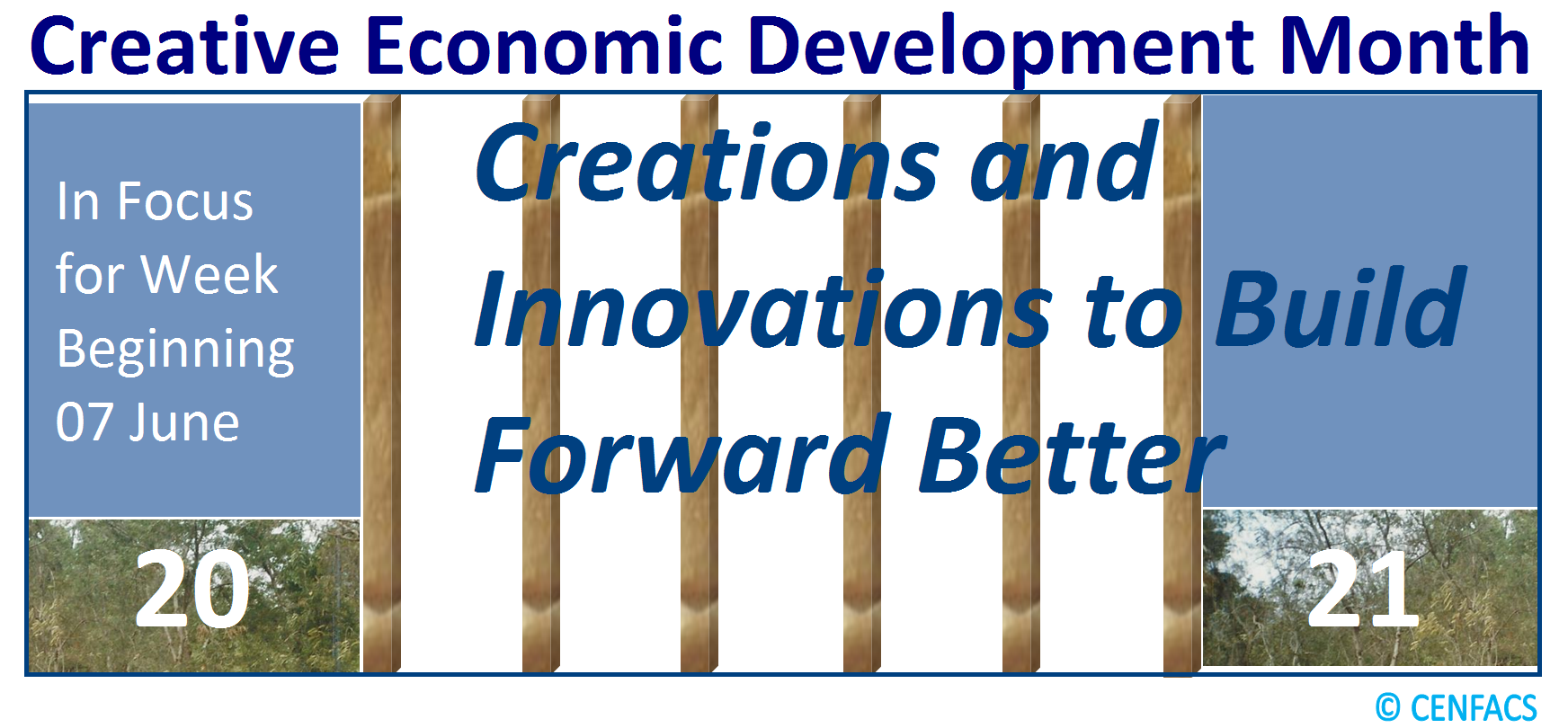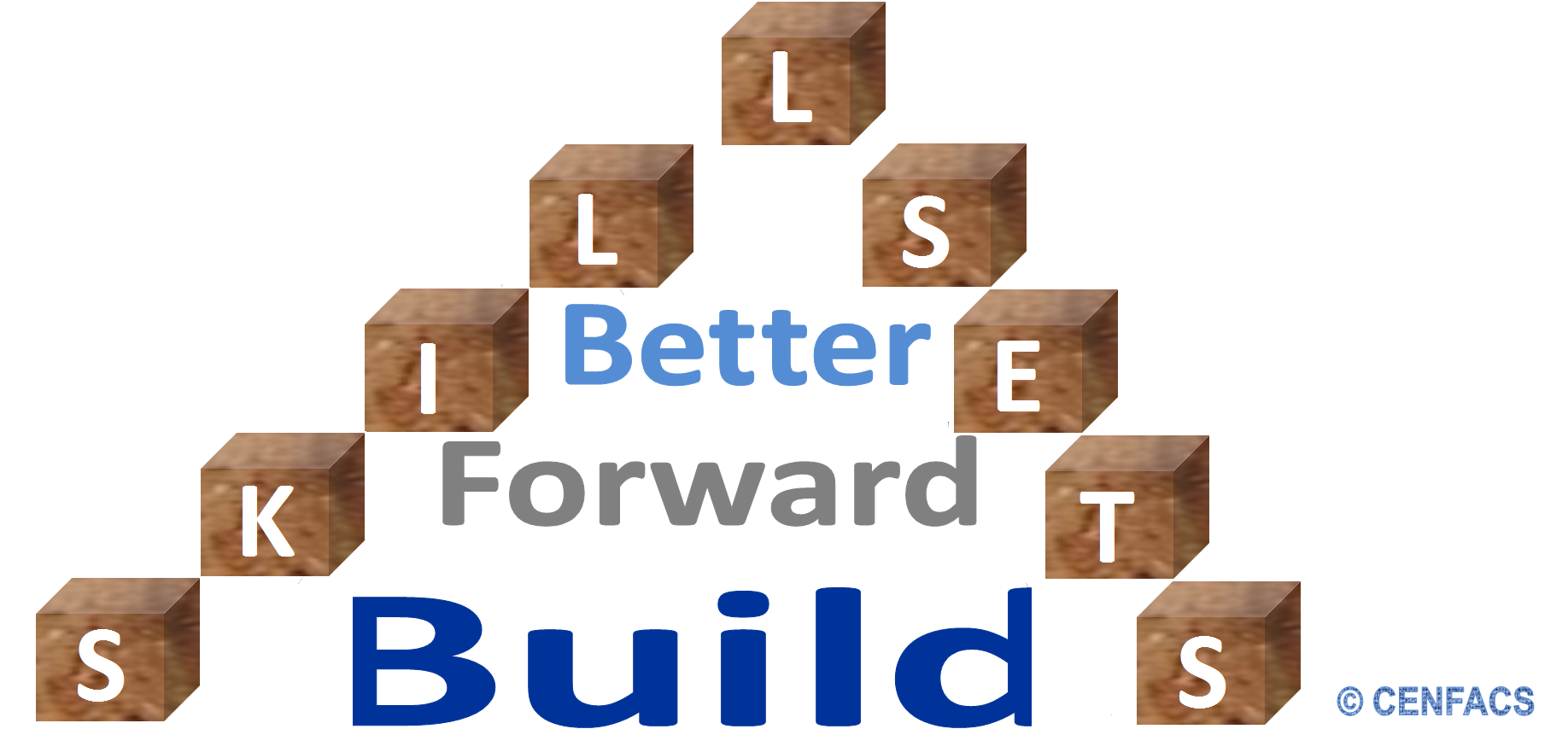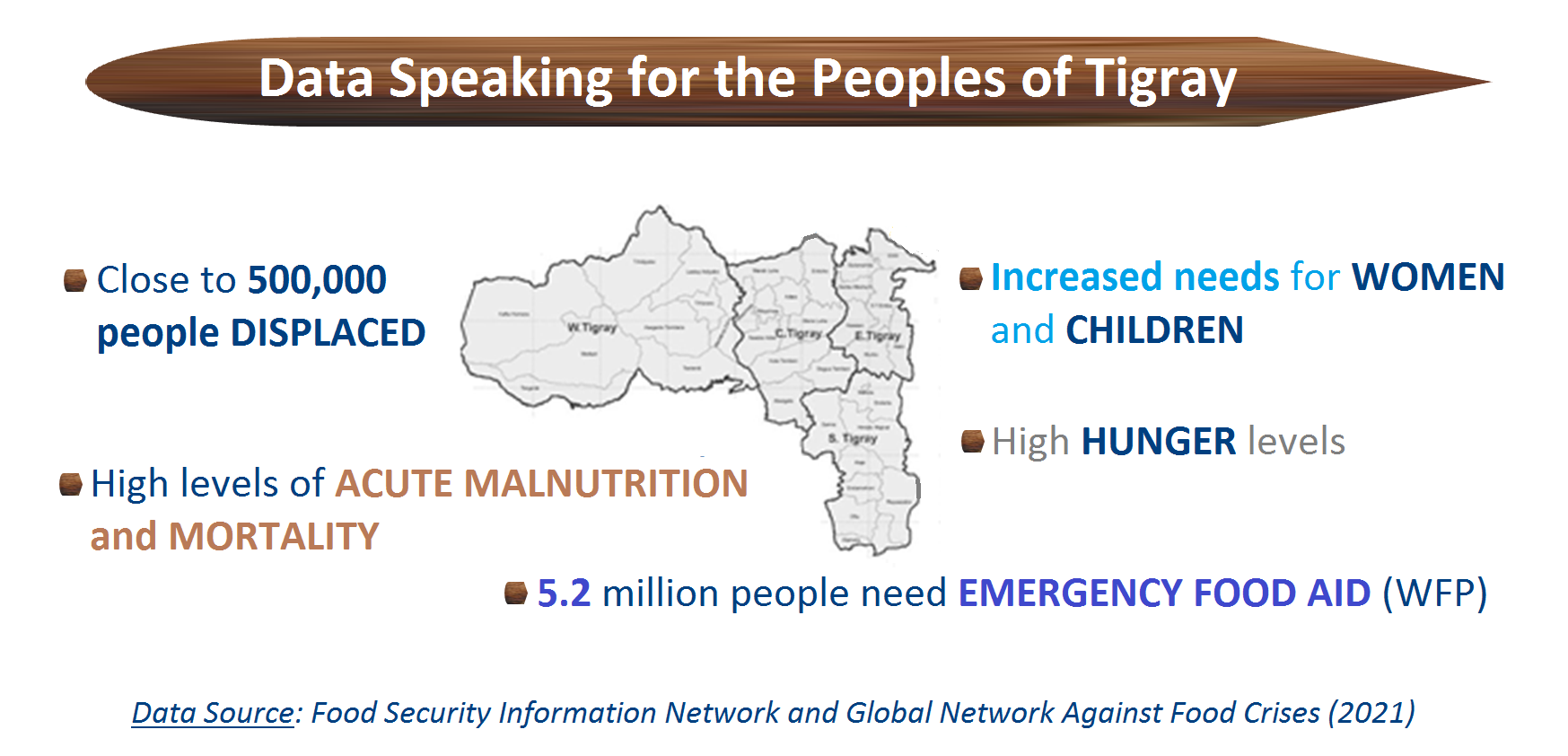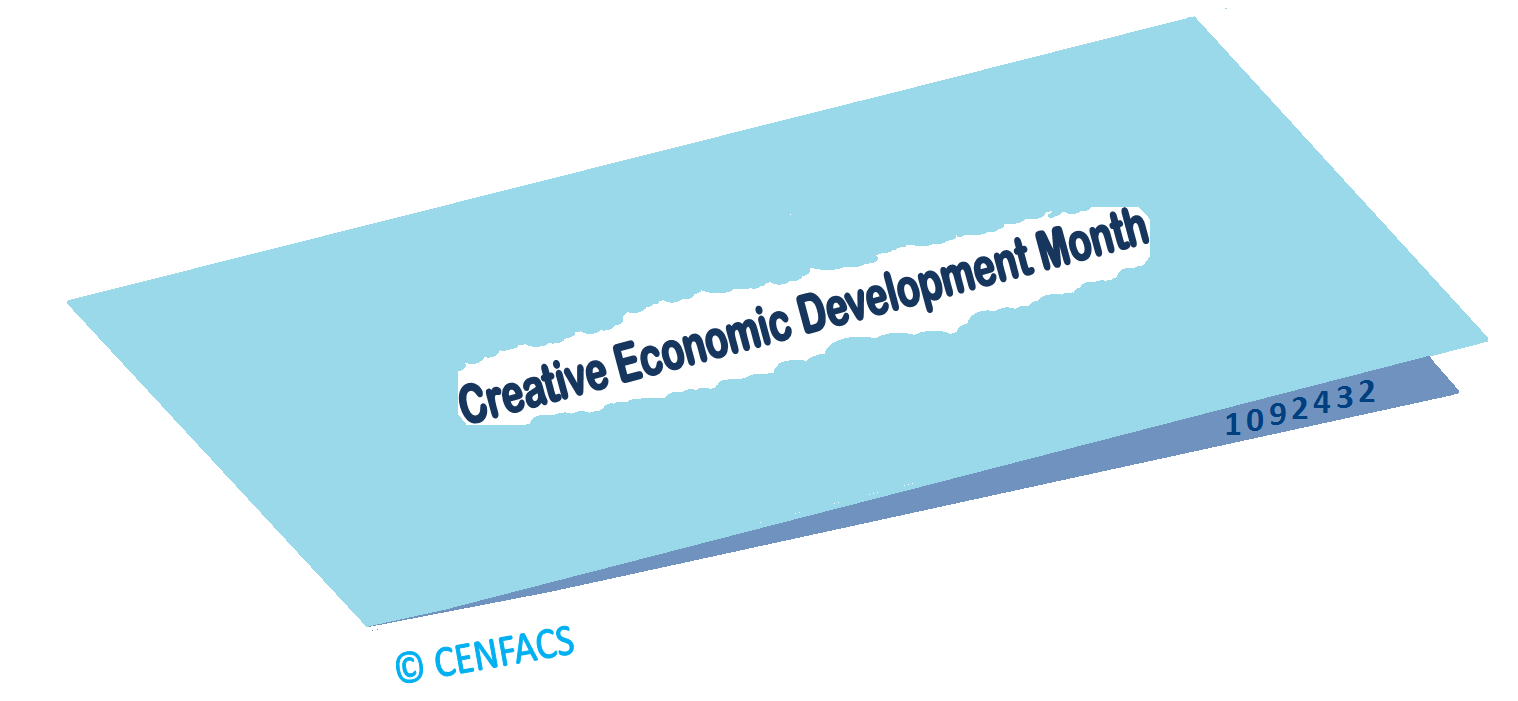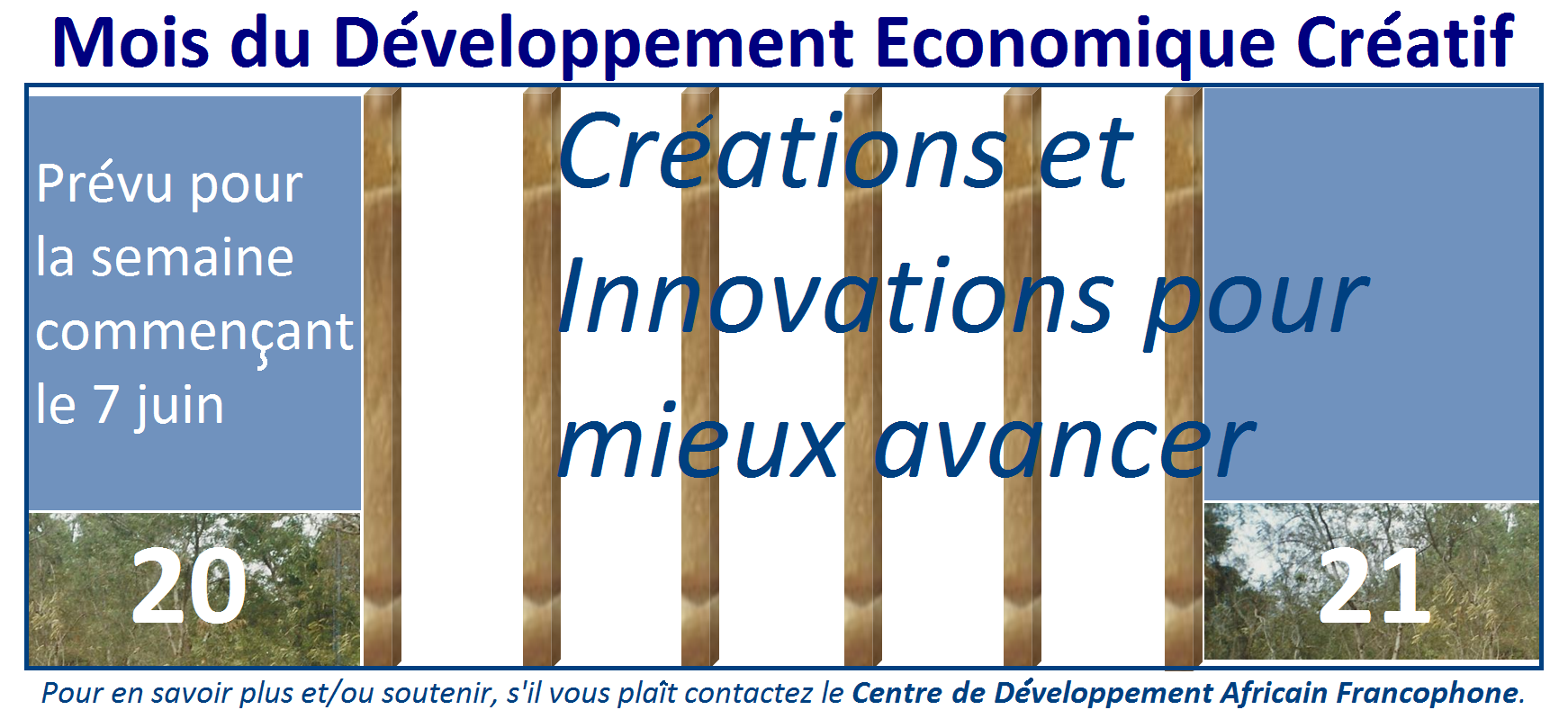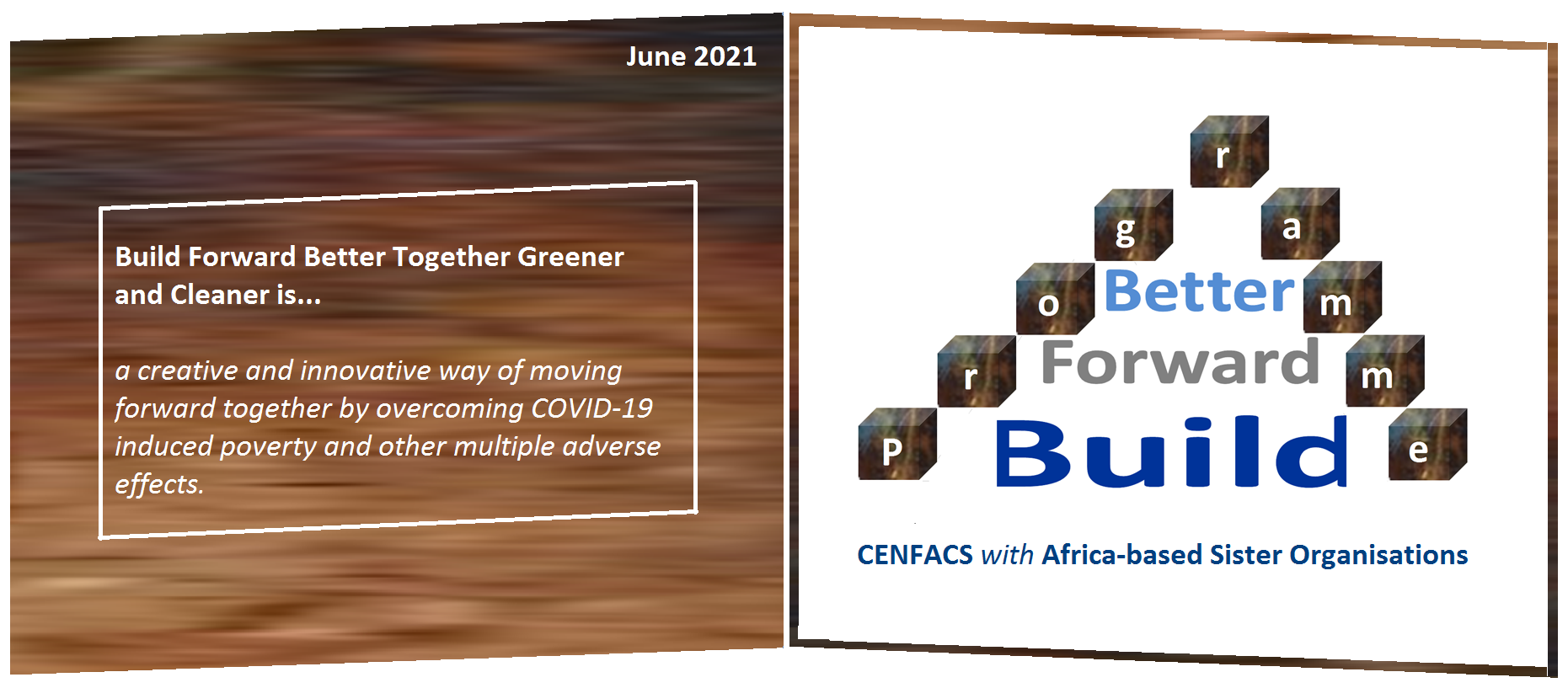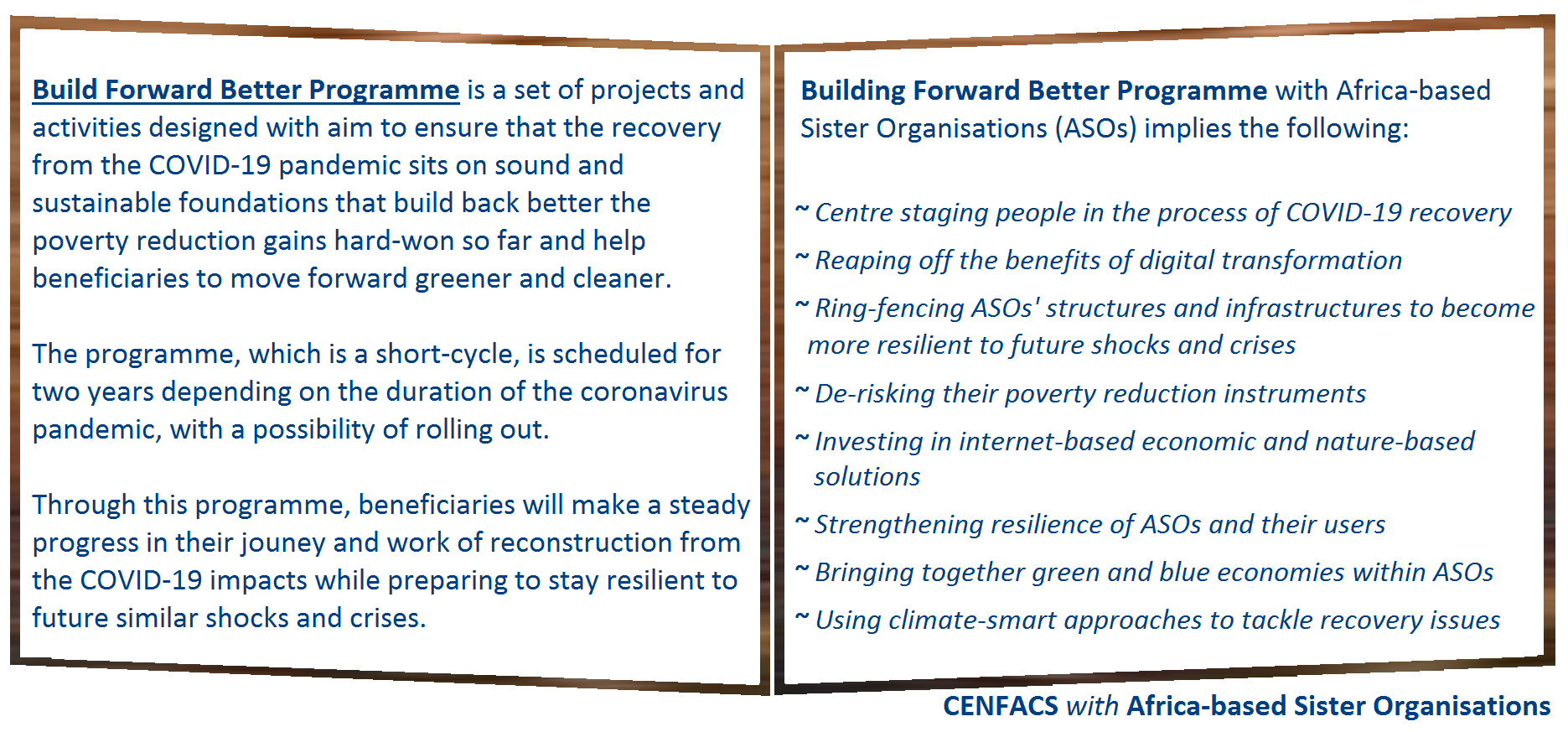Welcome to CENFACS’ Online Diary!
09 June 2021
Post No. 199
The Week’s Contents
• Creative Economic Development Month – In Focus for Week Beginning 07/06/2021: Creations and Innovations to Build Forward Better Together Greener and Cleaner
• Skills to Build Forward Better Together Greener and Greener
• Building Code and Poverty Reduction
… And much more!
Key Messages
• Creative Economic Development Month – In Focus for Week Beginning 07/06/2021: Creations and Innovations to Build Forward Better Together Greener and Cleaner
As planned, the first item of the Creative Economic Development Month is about the kinds of creations and innovations we need in order to build forward better together greener and cleaner during the easing of pandemic related restrictions and the resumption of mobility. Given the unprecedented impacts of COVID-19 and associated containment measures, one needs to create and innovate in order to tackle these impacts and pave the way for a new and better life.
The coronavirus pandemic and accidental damaging effects of containment measures have pushed many people in need to another territory of poverty. In some circumstances, they have changed the very nature of poverty and hardships. In respect, to build forward better from this changing nature of poverty and hardships, creations and innovations are needed, even requested. They are needed and demanded because one cannot just build like in the past; they need to build forward better together greener and cleaner.
Under the Main Development section of this post, we have provided more information about this first key message.
• Skills to Build Forward Better Together Greener and Greener
To build forward better, it requires skills (that is naturally acquired or developed dexterity) to do it. It demands more than the generic skills since we are in a completely different situation in which we are trying to move forward from a different type of crisis, from historical point of view.
To the conventional skills (like communication, networking, social intelligence, home economics, risk management skills, etc.), one needs to add other ones such as resilience, recovery, rehabilitation, reconstruction, creativity, togetherness, adaptability, investment, sustainable skills, etc. This addition should be done without forgetting the skills to build greener and cleaner environment.
Briefly, one may need a set or suite of new and revolutionary skills in order to build forward better together greener and cleaner. This set or suite will be made with both hard and soft skills to manage competing priorities in time of building forward together greener and cleaner.
• Building Code and Poverty Reduction
The 3rd key message is about the discussion we are having regarding the relationship between the building code and poverty reduction. It is about whether or not it is possible to make building code poverty reduction friendly and green aligned in the process of building forward better lives in the post-pandemic area.
This discussion is similar to the one we had about the mining code. Many thought it was not possible to insert poverty reduction commitment in this code. Experience has proved that it is possible to do it. Now, many defenders of poor are calling on the review of some mining conventions in some countries in Africa.
What is a building code?
There are many definitions about it. In the context of disaster risk management, we have selected the following terminology given by the United Nations/International Strategy for Disaster Reduction (1), which argued in 2009 that building code is
“A set of ordinances or regulations and associated standards intended to control aspects of the design, construction, materials, alteration and occupancy of structures that are necessary to ensure human safety and welfare, including resistance to collapse and damages”.
So, using this terminology, we are going to discuss the relationship between building code and poverty reduction in terms of the possibility of inserting poverty reduction criteria into building code as we are building forward better together from the legacies of the coronavirus pandemic. Inserting poverty reduction in the building code will mean that no one will be left behind the process of building forward better together greener and cleaner.
Those who would be interested in this discussion, they are welcome to usher in with their proposals or arguments.
To discuss the link between building code and poverty reduction, just contact CENFACS.
Extra Messages
• Tigray Food Appeal
• • What this appeal is about
This is an appeal regarding the food crisis and hunger situation in Tigray. We are continuing to appeal because the critical situation in Tigray does not show any signs of abating.
The following are what the Food Security Information Network (2) says about Tigray:
“The extremely concerning humanitarian situation in the northern region of Tigray continues to deteriorate due to fighting and conflict” (p. 26)
“Fighting broke out in many parts of Tigray in early November [2020] and rapidly deteriorate into a dire humanitarian crisis with access to essential services” (p. 51)
The data from the same source of information speak for the peoples of Tigray. We know that at this challenging time, it is not easy to support many causes even deserving ones. However, we are appealing to you to help reduce the drivers of food crisis in Tigray, which are conflict and insecurity.
• • What you can do to help
You can help the peoples of Tigray by
√ Talking to someone who has influence on what is happening on the ground to change life
√ Networking, campaigning, responding to a petition, and so on to make your contribution
√ Making a phone call or sending a mobile phone text message or even a tweet or taking part in a video conference to save hungry lives in Tigray
√ Raising your voice about the food crisis in Tigray at international humanitarian talks or rallies
√ Spreading the news in your social media networks and contacts about the issue and the potential threat this may bring to the Horn of Africa
√ Having some thoughts about what is happening in Tigray and on practical ways of helping the peoples of Tigray to build forward better from their food crisis
Although physical gatherings are still restricted or banned in some places because of the COVID-19 continuing lockdowns, most of the above actions can be done online and remotely.
CENFACS hopes you will act upon this food appeal to create and innovate so that the food sufferers in Ethiopia’s Tigray can get access to food and navigate their way to sustainable and inclusive peace.
• Arts and Design Project and e-Workshop: Making and Sending a p-Card or e-Card
For those who are trying to design and send a paper card (p-card) or an electronic card (e-card) as a way of participating in the Creative Economic Development month, please make sure that the poverty relief message you are conveying is without confusion. You can follow the criteria below.
• • Criteria for a good card design
When designing a card, it is better that your art or design work
√ contributes to inclusive and sustainable development goals
√ is a driver and enabler of sustainable development processes
√ is data or evidence-based as an expression of realities
√ is aligned with greenhouse gas emissions goals and targets
√ is capable of leading to new pathways for the creative economy
√ reflects on creative economic development
√ connects with the different sectors of the creative economy
√ adds value to nature-based solutions to design problems
√ is conducive to new opportunities for sustainable development
√ is supportive of learning and innovation for poverty relief and sustainable development
√ opens up a possibility of a model of working together
√ touches climate change issues (such as plastic pollution)
√ deals with sustainability issues (like conservation of the nature)
√ develops culture of poverty relief and sustainable development
Although these criteria seem to be quite a lot, it would be enough to meet as many as one can in the design of their p-card or e-card.
To create and send your card or support CENFACS’ Creative Economic Development month, please contact CENFACS.
• World Anti-poverty System: Uneven access to COVID-19 vaccine can justify the need of an International System for Poverty Reduction
Every time there is a global crisis, it is also a reminder of the best possible global mechanism of dealing with the crisis. The coronavirus pandemic is yet another opportunity to ask ourselves about the best system or set-up to deal with the crisis of magnitude of COVID-19.
One can ask themselves this question:
if we had an International System for Poverty Reduction (that is a World Anti-poverty System comparable to the institutions of Bretton Woods System), would this system help to better deal with the coronavirus crisis or not?
The same question could be raise about the access to COVID-19 vaccine and licences to produce it in Africa for example.
There could be pros and cons about such a system. However, given what is happening with the COVID-19 vaccine in some parts of the world like in Africa, an International System for Poverty Reduction would be in a better position to get the best deal for universal access to COVID-19 vaccine for all the poor.
If you think that uneven access to COVID-19 vaccine can help in the creation of an International System for Poverty Reduction, please let us know your arguments. If you do not think so, still let us know what you think.
You can join CENFACS’ Campaign for an International System for Poverty Reduction. To join, just contact CENFACS.
Main Development
• Creative Economic Development Month – In Focus for Week Beginning 07/06/2021: Creations and Innovations to Build Forward Better Together Greener and Cleaner
The main story of this post consists of the following items: our understanding of creations and innovations to build forward better together, aim and objectives of creations and innovations, types of these creations and innovations, their outcomes, their monitoring and evaluation, and reporting and sharing the results of our creations and innovations with others.
• • What are creations and innovations to build forward better?
Creations to build forward better are the generation of new ideas and solutions in a unique, original and different way to build and enhance human capital in order to reduce and/or end COVID-19 induced poverty and hardships. The context of these creations is of rebuilding and sustaining lives, infrastructures and institutions to move forward from COVID-19 crisis and containment measures.
To highlight this new context of rebuilding, the proposal prepared in June 2020 by the United Nations (3) country team in Iran stated that
“The overall intent in building forward better is not to go back to the pre-COVID-19 normal, but to pave the way for the new and better normal following the outbreak”
Similarly, innovations to build forward better are the application of new ideas to build forward better. They could also be about making changes in established creations by introducing new methods or ideas or products in order to enhance the process of building forward better.
• • Aim and objectives of creations and innovations to build forward better
To create and innovate to build forward better, there must be an aim; just as there should be objectives. The aim is the change we plan to achieve or the difference we want to make in creating and innovating to build forward better.
We know that the aim of our creations and innovations would be to reduce and possibly end poverty induced by the coronavirus and accidental containment measures. That is why we are helping in the process of building forward better.
We are also building forward better so that future generations do not experience the same poverty or any other new forms of poverty and hardships. We are furthermore building forward so that the generations to come do not feel their ability to satisfy their own needs compromised by our current behaviour or overuse/exploitation of natural resources.
To back up or deliver our core aim, we need objectives (that is, a set of things to aim at) when we create and innovate to build forward better. Amongst these objectives are: optimisation of the users’ utility in terms of satisfaction of needs to reduce poverty, improvement of users’ earning capacities, increase users’ share of renewables in the energy mix, support users in the process of finding occupational activities, etc.
These objectives will determine the strategic and operational policies of creations and innovations to adopt in order to meet the central aim of poverty reduction in the process of building forward better.
• • Types of creations and innovations to build forward better
• • • Types of creations to build forward better
Concerning the types of creations to build forward better, one can include those related to
∞ Inspiration
∞ Planning
∞ Matching plans with the community’s/Africa-based Sister Organisations’ needs
∞ Research analysis
∞ Data collection and treatment
∞ Establishing the need of building forward better
∞ Identifying constraints, risks and opportunity through feasibility study
∞ Selection of projects, models, activities, designers to build forward better
∞ Production of information needed to construct the process of building forward better
Etc.
One should as well align creation with innovation if they want their creativity becomes a reality.
• • • Types of innovations to build forward better
Regarding the types of innovations to build forward better, one can have the following:
∞ Innovations that introduce new technologies (for example an App to cover COVID-19 highly infected area)
∞ Innovations related to new product or service (for instance drones to find postcodes not covered by the COVID-19 vaccine)
∞ Innovations regarding a new method of producing poverty reduction or an improvement in the existing methods of poverty reduction (such as solar panels to capture solar power and provides heating energy for the energy poor at cheaper costs).
• • Green and clean creations and innovations to build forward better
We will be interested in creations and innovations that are environment-friendly (that is, they have a small or zero environmental impact) and reduce waste in the nature. In this respect, the process of building forward better needs to lead to a better natural resources management.
We are as well interested in creations and innovations that lower emissions of greenhouse gas, reduce climate-damaging carbon dioxide emissions, spearhead green energy solutions and increase the share of renewables in the energy mix in the process of creating and innovating for life, work and future.
We shall argue in depth about green and clean creations and innovations in two weeks’ time.
• • Creation and innovation outcomes
As result of creations and innovations work, there will be changes and effects as our Africa-based Sister Organisations (ASOs) and the community will be built forward better.
The outcomes for ASOs could be that they become
√ Digitally transformed
√ More resilient to future shocks and crises
√ Healthy and thriving organisations
√ Less risky in terms of their poverty reduction tools
√ Climate-smart
√ Remote working able
√ Better manager of natural resources
√ Better user of nature-based solutions to reduce poverty
Etc.
• • Monitoring and evaluation
There should be routine and systematic gathering of information on all aspects of creations and innovations to build forward better. In other words, one should systematically collect and analyse information to keep regular checks and balances on creations and innovations.
Likewise, we could assess what creations and innovations have achieved in relation to the overall objectives they were set up and the terms of reference of build forward better programme. This is to say that evaluation should be conducted regarding the efforts spent on the activities of generating new ideas and putting these creative ideas into practice. This should be done to find out whether or not these efforts are value for the process of building forward better.
• • Reporting and sharing the results of creations and innovations
Making a statement or an account about the results of creations and innovations, and sharing it with others can be a good way of getting people involved in what one is doing. It will also help to make the process of building forward better as a shareable and inclusive; particularly, when one wants this process to be of leaving no-one behind.
There are many ways one can share their creations and innovations to build forward better greener and cleaner from the coronavirus pandemic and accidental damages caused by the containment measures. These ways could include the following ones:
∞ Written texts or format
∞ Phone calls
∞ Audio tapes
∞ Short films
∞ Video calling and conferencing
∞ Podcasts
∞ Exhibitions (physical and/or online)
∞ Social media platforms
Etc.
The report should highlight the activities and accomplishments in terms of creations and innovations made in the context of building forward better.
To end this Main Development section of the current post, let us remind to everybody that the month of Creative Economic Development is not about CENFACS alone. It is the month to recollect together our makings and the application of these makings we have been doing throughout the year.
Likewise, this week of creations and innovations to build forward better is not about CENFACS solely. It is about the community, users and stakeholders to create and innovate to build forward better, and mostly to make their makings reduce poverty and hardships induced by the coronavirus and accidental damages caused by the containment measures. In this respect, we are all creators and innovators in the process of building forward better greener and cleaner.
To support the Creative Economic Development Month, please contact CENFACS. To share your creations and innovations to build forward better greener and cleaner, please also contact CENFACS.
_________
References
(1) https://www.unisdr.org/files/7817_UNISDRTerminologyEnglish.pdf (accessed June 2021)
(2) FSIN and Global Network Against Food Crises. 2021. Global Report on Food Crises 2021. Rome
http://https://www.fsinplatform.org/sites/default/files/resources/files/GRFC2021.pdf (accessed June 2021)
(3) https://unsdg.un.org/sites/defsult/files/2020-09/IRN_Socioeconomic-Response-PLan_2020_update.pdf (accessed June 2021)
_________
Help CENFACS keep the Poverty Relief work going this year.
We do our work on a very small budget and on a voluntary basis. Making a donation will show us you value our work and support CENFACS’ work, which is currently offered as a free service.
One could consider a recurring donation to CENFACS in the future.
Donate to support CENFACS!
FOR ONLY £1, YOU CAN SUPPORT CENFACS AND CENFACS’ PROJECTS, JUST GO TO http://cenfacs.org.uk/supporting-us/
Thank you for visiting CENFACS website and reading this post.
Thank you as well to those who made or make comments about our weekly posts.
We look forward to receiving your regular visits and continuing support throughout 2021 and beyond.
With many thanks.
